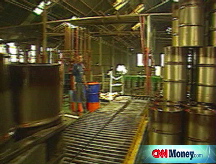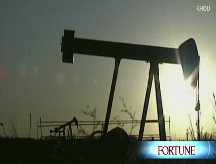Oil settles below $34
Economic slowdown continues to weigh on demand in the final day of the January contract; oil drops to $33.87.

NEW YORK (CNNMoney.com) -- Oil prices fell sharply Friday, on the last day of the January contract, as the global economic slowdown continues to clamp down on demand.
The price of crude for January delivery fluctuated mid-afternoon, before shedding $2.35 to settle at $33.87, nearly a five-year low.
The last time oil traded this low was Feb. 10, 2004, when it settled at the same price.
The February contract, which begins its front-month run on Monday, rose 69 cents to $42.36 a barrel in a trading day with very little price movement.
The February contract had nearly 10 times the volume of trades as compared to the January contract, according to Tom Pawlicki of MF Global Research in Chicago.
The low closing price of oil could set the pace for a rebound. That, in turn, could push up the price of oil in February, according to Pawlicki.
"If a price bottom is, in fact, formed, February crude could advance toward the $49.40 to $52.95 resistance range within the next one to two weeks," he wrote.
Stocks pared earlier gains Friday as investors weighed the pros and cons of the Bush Administration's plan to bail out the auto industry.
However, oil prices showed little reaction to the bailout plan for Detroit announced Friday, which makes $13.4 billion in federal loans available to General Motors (GM, Fortune 500) and Chrysler LLC almost immediately.
Investors continued to shrug off an OPEC production cut announced earlier in the week, which will take effect in January.
On Wednesday, the Organization of Petroleum Exporting Countries, an international trade organization whose members supply about 40% of the world's oil, elected to cut production by 2.2 million barrels a day, starting next month.
OPEC's action, and investor concern about the slowing global economy's impact on crude demand, sent the price down $3.54 to $40.06 a barrel on Wednesday.
"They're wondering whether OPEC can enforce this cut," because the budgets of many OPEC nations are already stretched incredibly thin, said Nimit Khamar, analyst with Sucden Financial in London.
Investors have largely ignored other OPEC production cuts made since September, totaling an additional 2 million barrels a day.
Falling demand: Oil prices have shed more than $100 a barrel since hitting a record high of $147.27 a barrel in July as worldwide demand began to decline.
In the United States, the world's largest oil consumer, supplies have been building as Americans cut back on driving.
U.S. crude inventories increased by 500,000 barrels last week, according to the Energy Department.
"We've got more oil than we know what to do with at the moment," said Bob Thomas, head of the energy group at Porter & Hedges, a Houston-based law firm that represents oil companies.
Consumers in the U.S. drove 100 billion fewer miles over the past year, according to a government report.
"We're seeing demand slip everywhere, including China," said Khamar.
Rapidly expanding export-based economies of nations such as China and India are beginning to suffer as much as their counterparts in the developed world, where cash-strapped citizens are consuming less of everything.
"It may take a while for supply and demand to match up," said Thomas.
Looking forward, the Energy Department said Wednesday that crude prices could reach $130 a barrel in 2030 as global supplies diminish. But it also predicted that demand for fuel would rise by only 1 million barrels a day during that time period.
-- CNNMoney.com staff writer Kenneth Musante contributed to this report. ![]()




